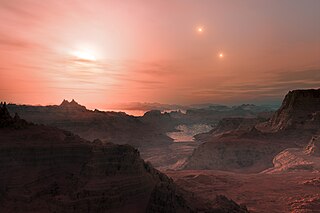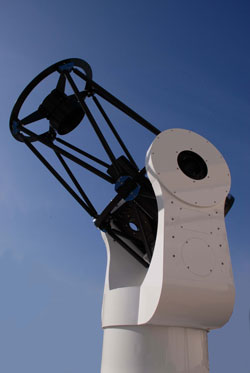Related Research Articles

An exoplanet or extrasolar planet is a planet outside the Solar System. The first possible evidence of an exoplanet was noted in 1917 but was not recognized as such. The first confirmation of detection occurred in 1992. A different planet, initially detected in 1988, was confirmed in 2003. As of 1 June 2023, there are 5,388 confirmed exoplanets in 3,979 planetary systems, with 859 systems having more than one planet. The James Webb Space Telescope (JWST) is expected to discover more exoplanets, and also much more about exoplanets, including composition, environmental conditions and potential for life.
GJ 1061 is a red dwarf star located 12 light-years from Earth in the southern constellation of Horologium. Even though it is a relatively nearby star, it has an apparent visual magnitude of about 13, so it can only be seen with at least a moderately-sized telescope.
Gliese 581 is a red dwarf star of spectral type M3V at the center of the Gliese 581 planetary system, about 20.5 light years away from Earth in the Libra constellation. Its estimated mass is about a third of that of the Sun, and it is the 101st closest known star system to the Sun. Gliese 581 is one of the oldest, least active M dwarfs known. Its low stellar activity improves the likelihood of its planets retaining significant atmospheres, and lessens the sterilizing impact of stellar flares.

A super-Earth is a type of exoplanet with a mass higher than Earth's, but substantially below those of the Solar System's ice giants, Uranus and Neptune, which are 14.5 and 17 times Earth's, respectively. The term "super-Earth" refers only to the mass of the planet, and so does not imply anything about the surface conditions or habitability. The alternative term "gas dwarfs" may be more accurate for those at the higher end of the mass scale, although "mini-Neptunes" is a more common term.

Transiting Exoplanet Survey Satellite is a space telescope for NASA's Explorer program, designed to search for exoplanets using the transit method in an area 400 times larger than that covered by the Kepler mission. It was launched on 18 April 2018, atop a Falcon 9 launch vehicle and was placed into a highly elliptical 13.70-day orbit around the Earth. The first light image from TESS was taken on 7 August 2018, and released publicly on 17 September 2018.

An exoplanet is a planet located outside the Solar System. The first evidence of an exoplanet was noted as early as 1917, but was not recognized as such until 2016; no planet discovery has yet come from that evidence. What turned out to be the first detection of an exoplanet was published among a list of possible candidates in 1988, though not confirmed until 2003. The first confirmed detection came in 1992, with the discovery of terrestrial-mass planets orbiting the pulsar PSR B1257+12. The first confirmation of an exoplanet orbiting a main-sequence star was made in 1995, when a giant planet was found in a four-day orbit around the nearby star 51 Pegasi. Some exoplanets have been imaged directly by telescopes, but the vast majority have been detected through indirect methods, such as the transit method and the radial-velocity method. As of 1 June 2023, there are 5,388 confirmed exoplanets in 3,979 planetary systems, with 859 systems having more than one planet. This is a list of the most notable discoveries.
The Lick–Carnegie Exoplanet Survey (LCES) is a search for exoplanets using the Keck I optical telescope of the W. M. Keck Observatory in Hawaii. The survey is sponsored by NASA and the National Science Foundation. The survey comprises a decade of observations. The survey is led by Steven Vogt, professor of astronomy and astrophysics at University of California at Santa Cruz, and R. Paul Butler of the Carnegie Institution.

Gliese 667 Cc is an exoplanet orbiting within the habitable zone of the red dwarf star Gliese 667 C, which is a member of the Gliese 667 triple star system, approximately 23.62 light-years away in the constellation of Scorpius. The exoplanet was found by using the radial velocity method, from radial-velocity measurements via observation of Doppler shifts in the spectrum of the planet's parent star.
HIP 57050 is a red dwarf 36 light-years from the Sun with a planetary companion HIP 57050 b.

PH2, also known as Kepler-86, or KIC 12735740, is a G-type star 1,120 light-years distant within the constellation Cygnus. Roughly the size and temperature of the Sun, PH2 gained prominence when it was known to be the host of one of 42 planet candidates detected by the Planet Hunters citizen science project in its second data release. The candidate orbiting around PH2, known as PH2 b, had been determined to have a spurious detection probability of only 0.08%, thus effectively confirming its existence as a planet.

Kepler-438b is a confirmed near-Earth-sized exoplanet. It is likely rocky. It orbits on the inner edge of the habitable zone of a red dwarf, Kepler-438, about 472.9 light-years from Earth in the constellation Lyra. It receives 1.4 times our solar flux. The planet was discovered by NASA's Kepler spacecraft using the transit method, in which the dimming effect that a planet causes as it crosses in front of its star is measured. NASA announced the confirmation of the exoplanet on 6 January 2015.

The Nexus for Exoplanet System Science (NExSS) initiative is a National Aeronautics and Space Administration (NASA) virtual institute designed to foster interdisciplinary collaboration in the search for life on exoplanets. Led by the Ames Research Center, the NASA Exoplanet Science Institute, and the Goddard Institute for Space Studies, NExSS will help organize the search for life on exoplanets from participating research teams and acquire new knowledge about exoplanets and extrasolar planetary systems.

GJ 3470 b is an exoplanet orbiting the star GJ 3470, located in the constellation Cancer. With a mass of just under 14 Earth-masses and a radius approximately 4.3 times that of Earth's, it is likely something akin to Neptune despite the initially strong belief that the planet was not covered in clouds like the gas giants in the Solar System.

The MINiature Exoplanet Radial Velocity Array (MINERVA) is a ground-based robotic dedicated exoplanet observatory. The facility is an array of small-aperture robotic telescopes outfitted for both photometry and high-resolution Doppler spectroscopy located at the U.S. Fred Lawrence Whipple Observatory at Mt. Hopkins, Arizona. The project's principal investigator is the American astronomer Jason Eastman. The telescopes were manufactured by PlaneWave Instruments.

SPECULOOS (Search for habitable Planets EClipsing ULtra-cOOl Stars) is a project consisting of SPECULOOS Southern Observatory (SSO) at the Paranal Observatory in Chile and SPECULOOS Northern Observatory (SNO) at the Teide Observatory in Tenerife.

K2-288Bb is a super-Earth or mini-Neptune exoplanet orbiting in the habitable zone of K2-288B, a low-mass M-dwarf star in a binary star system in the constellation of Taurus about 226 light-years from Earth. It was discovered by citizen scientists while analysing data from the Kepler spacecraft's K2 mission, and was announced on 7 January 2019. K2-288 is the third transiting planet system identified by the Exoplanet Explorers program, after the six planets of K2-138 and the three planets of K2-233.
GJ 3470 is a red dwarf star located in the constellation of Cancer, 96 light-years away from Earth. With a faint apparent magnitude of 12.3, it is not visible to the naked eye. It hosts one known exoplanet.

Alberto Caballero is a Spanish astronomer and science communicator. He is known for having identified a Sun-like star in the sky region where the Wow! signal came from as one of the possible sources of the radio signal. Caballero is also known for founding and coordinating the Habitable Exoplanet Hunting Project, an international effort consisting of more than 30 observatories searching for nearby potentially habitable exoplanets. Data is collected 24/7 from specific stars by observatories located both in the Northern and Southern hemispheres, and an initial list of exoplanet candidates was made public in 2020.
References
- ↑ Carter, Jamie (2019). "Inside The 24/7 Search For Another Habitable Planet Within 100 Light Years Of Earth". Forbes.
- ↑ "SETI Institute". www.facebook.com. Retrieved 2020-02-02.
- ↑ "Observatories". 2019.
- ↑ Maloney, Dan (2020-01-13). "Habitable Exoplanets Hack Chat". Hackaday. Retrieved 2020-02-05.
- ↑ Gilster, Paul (2019). "Amateur Astronomers Join Hunt for Exoplanets". Centauri Dreams.
- ↑ "What is the Habitable Exoplanet Hunting Project?". @SETIInstitute. 2019-11-26.
- ↑ Brickhouse, Duke (2019-12-07). "Inside The Search For Another Habitable Planet Within 100 Light Years Of Earth". Exo News. Retrieved 2020-02-05.
- ↑ "Principium (page 16)" (PDF).
- ↑ "News from variable stars' world and from our organisation". 2019.
- ↑ "Alles over Sterrenkunde". allesoversterrenkunde.nl. Retrieved 2020-08-05.
- ↑ Massa, Martina (2020-07-22). "Pianeta in zona abitabile scoperto intorno a nana rossa lontana 100 anni luce". Notizie scientifiche.it (in Italian). Retrieved 2020-07-22.
- ↑ "Сообщается о первом открытии экзопланеты астрономами-любителями". Naked Science. 2020-07-22. Retrieved 2020-07-24.
- ↑ "Астрономы-любители впервые открыли экзопланету". Popmech.ru (in Russian). Retrieved 2020-07-24.
- ↑ Tomaswick, Andy (2020-07-28). "Saturn-sized Planet Found in the Habitable Zone of Another Star. The First Planet Completely Discovered by Amateur Astronomers". Universe Today. Retrieved 2020-07-29.
- ↑ "Oct 19th: The Habitable Exoplanet Hunting Project". Cosmoquest. 2019.
- ↑ "Saturn-Like Exoplanet Found in Habitable Zone of Gliese 3470 | Astronomy | Sci-News.com". Breaking Science News | Sci-News.com. Retrieved 2020-07-21.
- ↑ Beaty, James. "Local astronomer says he's detected new planet". McAlester News-Capital. Retrieved 2020-07-22.
- ↑ Scott, Phillip; Walter, Bradley; Ye, Quanzhi; Mitchell, David; Heiland, Leo; Gao, Xing; Palado, Alejandro; Otabek, Burkhonov; Casal, Jesus Delgado; Hill, Colin; Garcia, Alberto (2020-07-14). "GJ 3470 c: A Saturn-like Exoplanet Candidate in the Habitable Zone of GJ 3470". arXiv: 2007.07373 [astro-ph.EP].
- ↑ "The Extrasolar Planet Encyclopaedia — GJ 3470 c". exoplanet.eu. Retrieved 2020-07-16.
- ↑ Maloney, Dan (2020-07-19). "Hackaday Links: July 19, 2020". Hackaday. Retrieved 2020-07-20.